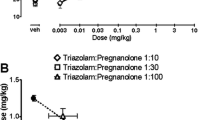Abstract
Clinical reports have suggested that propranolol, a Β-adrenergic blocker, has antianxiety properties. In the present laboratory experiments, this suggestion was explored by testing propranolol and chlordiazepoxide in rat lever-pressing conflict procedures that selectively identify antianxiety compounds. Chlordiazepoxide produced anticonflict effects in such a procedure at doses from 1.25 to 40 mg/kg. Propranolol, tested at doses of 2.5 to 80 mg/kg, did not produce the anticonflict pattern typical of standard antianxiety agents, which is characterized by progressive dose-related increases in punished responding that frequently are several 100% above control levels. In contrast, the largest increases produced by propranolol, which occurred in the 10–40 mg/kg dose range, were 18–26% above control; only the 26% increase observed at the 20 mg/kg dose was statistically significant. In a different conflict test, a 40 mg/kg dose of propranolol was found to have a slight, but not significant, anticonflict effect. When this dose level was combined with doses of 2.5, 5, or 10 mg/kg of chlordiazepoxide p.o., the combined treatments produced greater anticonflict effects than did the corresponding individual doses of chlordiazepoxide.
Similar content being viewed by others
References
Bainbridge, J. G., Greenwood, D. T.: Tranquillizing effects of propranolol demonstrated in rats. Neuropharmacology 10, 453–458 (1971)
Bonn, J. A., Turner, P., Hicks, D. C.: Beta-adrenergic receptor blockade with practolol in treatment of anxiety. Lancet 1972, 814–815
Cook, L., Catania, A. C.: Effect of drugs on avoidance and escape behavior. Fed. Proc. 23, 818–835 (1964)
Cook, L., Davidson, A. B.: Effects of behaviorally active drugs in a conflict-punishment procedure in rats. In: The Benzodiazepines. S. Garattini, E. Mussini, and L. O. Randall, eds. New York: Raven Press 1973
Davidson, A. B., Cook, L.: Effects of combined treatment with trifluoperazine-HCl and amobarbital on punished behavior in rats. Psychopharmacologia (Berl.) 15, 159–168 (1969)
Edwards, A. L.: Experimental design in psychological research, 3-rd ed., p. 130. New York: Holt, Rinehart and Winston 1968
Geller, I., Seifter, J.: The effects of meprobamate, barbiturates, d-amphetamine and promazine on experimentally induced conflict in the rat. Psychopharmacologia (Berl.) 1, 482–492 (1960)
Greenblatt, D. J., Shader, R. I.: On the psychopharmacology of beta adrenergic blockade. Curr. ther. Res. 14, 615–625
Herman, Z. S.: Influence of some psychotropic and adrenergic blocking agents upon amphetamine stereotyped behavior in white rats. Psychopharmacologia (Berl.) 11, 136–142 (1967)
Hermansen, K.: Effect of different Β-adrenergic receptor blocking agents on hexobarbital induced narcosis in mice. Acta pharmacol. (Kbh.) 27, 453–460 (1969)
Leszkovszky, G., Tardos, L.: Some effects of propranolol on the central nervous system. J. Pharm. Pharmacol. 17, 518–520 (1965)
Murmann, W., Almirante, L., Saccani-Guelfi, M.: Central nervous system effects of four Β-adrenergic receptor blocking agents. J. Pharm. Pharmacol. 18, 317–318 (1966)
Sepinwall, J., Grodsky, F. S.: Effects of cholinergic stimulation or blockade of the rat hypothalamus on discrete-trial conflict behavior. Life Sci. 8 (Pt. 2), 45–52 (1969)
Sullivan, J. L., Segal, D. S., Kuczenski, R. T., Mandell, A. J.: Propranolol-induced rapid activation of rat striatal tyrosine hydroxylase concomitant with behavioral depression. Biol. Psychiat. 4, 193–203 (1972)
Suzmann, M. M.: The use of beta-adrenergic blockade with propranolol in anxiety syndromes. Postgrad. med. J. (Suppl. 47), 104–108 (1971)
Waal, H.: Propranolol-induced depression. Brit. med. J. 1967 II, 50
Wheatley, D.: Comparative effects of propranolol and chlordiazepoxide in anxiety states. Brit. J. Psychiat. 115, 1411–1412 (1969)
Author information
Authors and Affiliations
Rights and permissions
About this article
Cite this article
Sepinwall, J., Grodsky, F.S., Sullivan, J.W. et al. Effects of propranolol and chlordiazepoxide on conflict behavior in rats. Psychopharmacologia 31, 375–382 (1973). https://doi.org/10.1007/BF00421281
Received:
Issue Date:
DOI: https://doi.org/10.1007/BF00421281



